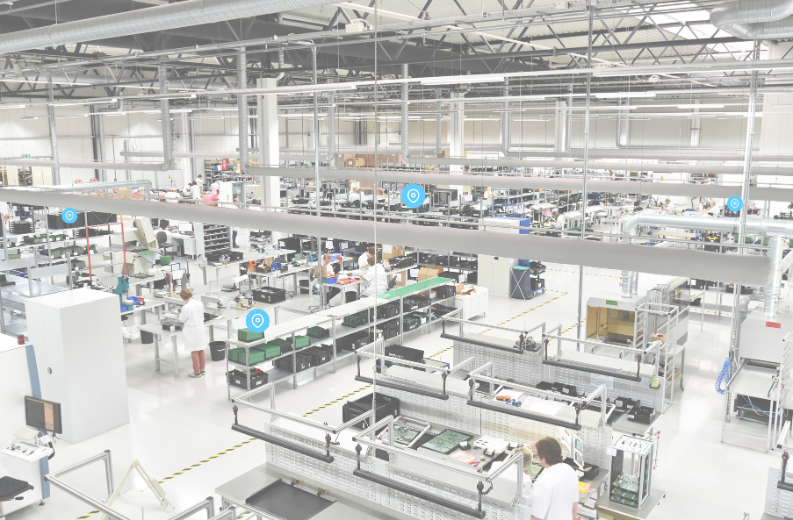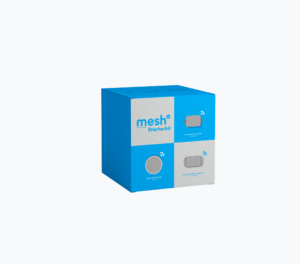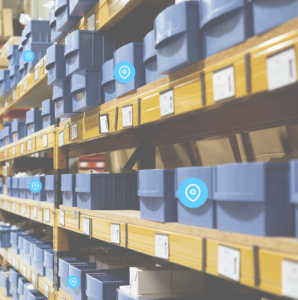More efficient processes with the real-time localization system in digital manufacturing
The industry is changing: companies are increasingly relying on real-time data to make processes more transparent, flexible and efficient. The shortage of skilled workers and the aging workforce are among the driving factors that companies must actively counteract. A key technology for this is a real-time localization system that records the location of assets, goods carriers and production orders in real time.
But what challenges, apart from the shortage of skilled workers, are there in manufacturing today that make the use of RTLS so valuable?
The challenges of the manufacturing industry and how RTLS solves them
Many production managers struggle with inefficient processes, inaccurate location information and long search times. A lack of transparency in work-in-progress (WIP) leads to delays, while paper-based documentation and delayed material replenishment inhibit productivity.
A proven first step towards optimization is value stream analysis. It helps companies identify waste in production processes, visualize bottlenecks and improve material flow. However, traditional value stream analysis is often based on manual data collection.
This is where a real-time localization system comes into play: by automatically capturing location and movement data, it provides precise, data-based insights into material and production flow. Companies can not only analyze bottlenecks once, but continuously monitor and optimize their processes in real time.
Benefits of RTLS in the manufacturing industry
The introduction of real-time localization systems (RTLS) offers numerous advantages for companies. The precise location tracking of goods carriers, tools and materials allows processes to be optimized, resources to be used more efficiently and costs to be reduced. At the same time, employees benefit from reduced search times and increased productivity.
Process optimization through precise location tracking
With RTLS, companies always have an overview of the location of tools, materials or transport vehicles. This reduces long search times and optimizes the flow of materials in production. By minimizing machine downtime due to missing equipment, production processes run more smoothly.
Time savings for employees
A major advantage of RTLS is the significant reduction in search times. Production employees no longer have to spend valuable minutes or even hours finding tools or materials. This allows them to focus more on their core tasks, which has a direct impact on productivity and satisfaction in their day-to-day work. The same workforce can handle more work and actively counteract the shortage of skilled workers.
Reducing costs through better resource utilization
RTLS enables more targeted use of resources. By knowing the current location and status of their operating resources at all times, companies can avoid overstocking or stockouts. For example, the exact demand for forklifts can be calculated and adjusted based on actual usage.
Paperless processes and sustainability
RTLS is driving digital transformation and fully digitizing paper-based processes. Manual documentation, routing slips and inventory lists are no longer needed, which increases efficiency. At the same time, reduced paper consumption lowers the environmental impact and improves sustainability.
The targeted use of RTLS technologies can therefore optimize production processes, reduce costs and make workflows more efficient – a decisive competitive advantage for manufacturing.
Use cases for RTLS in manufacturing
Real-time order tracking & automated process management
In a modern production environment, it is crucial to know the current status of an order at all times. RTLS technology makes it possible to track production orders in real time, so that production managers know exactly where a product is in the manufacturing process. Automatic status updates seamlessly track work-in-progress (WIP) and detect delays and bottlenecks early on. At the same time, the system can automatically trigger processes – for example, the replenishment of materials or a downstream quality inspection.
Asset Tracking: Keep an eye on materials and tools at all times
Missing tools or materials often lead to production stoppages. With RTLS, companies can keep track of all assets in the manufacturing environment. Employees can find the equipment they need immediately, without having to search for it. The system monitors the use of tools and reports immediately if they are used outside the designated area. This increases efficiency and safety in production.
Material replenishment (eKanban) for smooth processes
An efficient material flow is crucial to avoid production interruptions. With RTLS and a smart eKanban system, material supply is automated and seamlessly controlled. Cavea uses trackable ESL tags (ePaper) on each load carrier to monitor inventory in real time. With no manual scanning required, the system sends automatic replenishment notifications so that the required materials are provided in a timely manner. Direct synchronization with ERP and other inventory applications ensures that production managers always have an accurate overview of the current material status. Manual bookings or time-consuming inspections are eliminated, reducing errors and increasing productivity. The result: a continuous flow of materials that avoids bottlenecks and keeps production running.
Automated process quality control
Quality assurance plays a crucial role in manufacturing. With RTLS-based process control, companies can automate quality inspections and increase their efficiency. This ensures that process steps are carried out in the correct order and that materials are only processed within the allotted time. As a result, the error rate is reduced and production standards are reliably met.
With these practical RTLS applications, companies can optimize their production processes, avoid bottlenecks and sustainably increase efficiency in manufacturing.
Implementing RTLS: What should companies look out for?
The successful introduction of a real-time localization system (RTLS) requires careful planning to ensure maximum benefit for production.
One crucial aspect is the question of how accurately objects need to be tracked and how often position updates are required. The higher the precision and the update rate, the more complex and costly the implementation. It is therefore advisable to use high-precision technologies only where they are really needed – for example, for critical production processes. In less sensitive areas, a more cost-effective solution with a lower update rate may suffice.
Selecting the right technology for the respective application
The choice of the appropriate RTLS technology depends on the specific requirements and the area of application. Cavea’s TRIBRID® Tag is an ideal solution as it integrates several technologies – such as BLE, RFID, Cavea Wirepas Mesh and AOA – and allows companies to use the best technology for their use case.

Conclusion: RTLS as a key technology for digital manufacturing
Real-time localization is a central building block of modern manufacturing. It optimizes production processes, reduces search times, improves resource utilization and ensures seamless automation. Companies that rely on RTLS technologies benefit from higher efficiency, lower costs and increased production quality. This helps to counteract current challenges such as the shortage of skilled workers.
As digitization continues to advance, RTLS will play an even greater role in industry. Integration into existing IT systems, open standards like Omlox and flexible solutions like the TRIBRID® tag enable scalable and future-proof implementation.
Now is the right time to test the advantages of RTLS in your own production. Companies that want to optimize their manufacturing processes and remain competitive should act now.
Find out more about our solutions and start your smart factory transformation!

